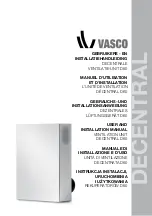
Backdraft
Damper
Leaf Hinge
Installed Vertically
(Recommended)
Outdoors
Damper for
balancing
airflows
Return Air
Cold Air
Return
Forced Air
Furnace
Exhaust Air from various
parts of building.
Stale Air to Outside
Airflow:
Fresh Air from Outside
Stale Air from Inside
Fresh Air to Inside
The partially dedicated installation draws stale air from specific points in the house and
introduces an equal amount of fresh air into the cold air return as illustrated in the following
building figures.
Key Points
The ERV unit must be balanced.
• It is mandatory that the furnace blower run continuously or ERV operation be interlocked
with the furnace blower to evenly distribute the fresh air throughout the house. Refer to
building code.
* Refer to “Interlocking ERV to Air Handler / Furnace Blower” on page 24.
• The duct configuration may change depending on the ERV model. See specifications for
your unit.
• Check local codes and authority having jurisdiction for acceptance.
Installation Notes
• See unit specifications for exact port locations.
• Unit is normally balanced on HIGH speed with the furnace blower ON.
• A minimum separation of 40” (one meter) is recommended between the two direct connections.
• The exhaust air connection should be upstream of the supply air connection to prevent exhausting any fresh air.
• Weatherhoods are to be installed in accordance with local building codes or manufacturer recommendations.
• The airflow must be confirmed on site using the balancing procedures found in this manual.
Installation Methods - Partially Dedicated
Figure 14. Partially Dedicated System
Figure 15. Direct Connection of Supply Air Stream to the Furnace Cold Air Return (Stale air drawn from key areas of home)
Residential Energy Recovery Ventilators
16
®
















































